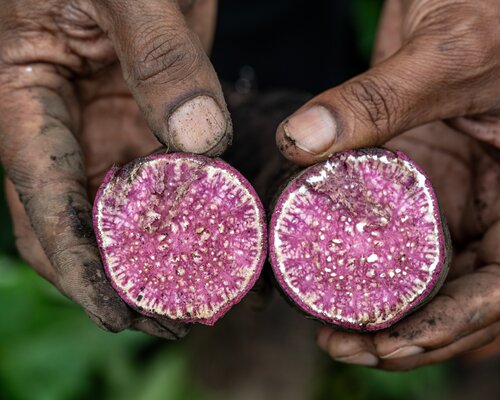Sweetpotato
Ipomoea batatas
Crop Overview
Sweetpotato (Ipomoea batatas (L.) Lam.) is a globally important root vegetable known for its sweet flavor and nutritional value. It is the third-most important root crop globally, after potato and cassava. The crop is believed to have originated in Central or South America, with evidence of domestication dating back to 5,000 years ago. It has a secondary centre of diversity in New Guinea. Today, sweetpotato is cultivated in over 100 countries worldwide. The largest areas planted are found in China, Nigeria and Tanzania.
Common names include sweetpotato in English, patate douce in French, shakarkand in Hindi, batata and camote in Spanish and hóngshǔ or fānshǔ in Mandarin Chinese.
Characteristics, Cultivation and Agricultural Practices
Sweetpotatoes thrive in diverse climates but prefer well-drained, sandy loam soils with good organic matter content. They require warm temperatures and can tolerate drought conditions, making them suitable for regions with variable rainfall. Sweetpotato has relatively few natural enemies but common pest and disease problems include sweetpotato weevils and various viruses. Proper crop rotation and integrated pest management practices can mitigate these challenges.
Under optimal growing conditions, sweetpotato can yield 40 tonnes of roots or more per hectare. It is commonly grown in both smallholder farms and large-scale agricultural systems. Production methods range from traditional subsistence farming to more intensive commercial operations, using techniques such as plastic mulch for moisture retention and advanced pest management strategies.
Nutritional, Economic and Medicinal Value
Sweetpotatoes are renowned for their impressive nutritional profile. The tuberous roots are rich in complex carbohydrates, vitamins A (in the form of beta-carotene), B, C and E and calcium, potassium, copper and iron. The high fiber content aids digestion and promotes gut health. The orange-fleshed varieties are particularly noted for their health benefits, including enhancing immune function and promoting eye health. Purple-fleshed varieties are believed to have cancer-preventing properties.
Sweetpotatoes are an important part of local diets, particularly in Africa, Asia and the Americas. They are prepared in various forms, such as boiled, roasted or mashed, and are commonly used in traditional dishes and desserts. Young leaves and shoots are also used as a vegetable. Starch and flour can be made from the roots, opening up potential business opportunities. The above-ground parts of the plant can be used as animal feed.
Beyond food, sweetpotatoes have potential applications in biofuel production.
Cultural Importance
Sweetpotatoes feature prominently in cultural practices and festivities around the world. It features as a traditional Thanksgiving celebration dish in the United States, particularly in sweetpotato pie. It is even the official state vegetable of North Carolina. Sweetpotato is used in many cultural traditions and rituals, symbolizing abundance and prosperity. In the Pacific Islands, for example, it is often included in traditional feasts and ceremonial dishes. In Papua New Guinea, sweetpotato has a spiritual significance and is a symbol of peace. Moreover, in many cultures the harvesting season is associated with community gatherings, where families and friends come together to celebrate the bounty. Sweetpotato is also used in traditional Chinese medicine to support healthy digestion.
Gender Perspectives
Sweetpotato is widely grown as a subsistence crop and is often considered a woman’s crop. Women bear much of the burden of land preparation, weeding, harvesting and selling the harvest. Women are the main producers and sellers of sweetpotato in Papua New Guinea and Indonesia, for example. In Kenya, women have more control over production and marketing of traditional sweetpotato varieties than over orange-fleshed varieties, which have higher commercial value. In Ghana, land preparation, planting, weeding and application of fertilizer is mainly done by men, while women play a greater role in harvesting and are mainly responsible for marketing the produce.
Why is the Crop Underutilized?
Although sweetpotato is widely cultivated, it is considered an opportunity crop by the Vision for Adapted Crops and Soils (VACS) initiative and was included for consideration in stakeholder meetings in partner countries. In Tanzania, many participants were particularly excited about orange and purple-fleshed sweetpotatoes due to their nutritional content. There are issues with the adoption of orange-fleshed sweetpotatoes because they have a mushy texture after cooking. Challenges to widening the use of sweetpotato include its lack of drought tolerance and the need for low night-time temperatures to initiate development of the tuberous roots. This makes the crop vulnerable to climate change. Lack of good-quality planting material is often cited as a constraint to greater adoption of the crop.
Diversity Available in Genesys
As of December 2024, Genesys, the online information platform about plant genetic resources for food and agriculture conserved in genebanks worldwide, lists nearly 10,000 samples of sweetpotato. The largest holdings are at:
- The International Potato Center – 5,596 samples.
- Empresa Brasileira de Pesquisa Agropecuária (EMBRAPA) in Brazil – 956 samples.
- The Plant Genetic Resources Conservation Unit, Southern Regional Plant Introduction Station, University of Georgia in the USA – 658 samples.
More than half of the samples are recorded as traditional cultivars or landraces, and there are more than 1,200 samples categorized as improved varieties or breeding or research materials.
Current Breeding Efforts
Major breeding programs for sweetpotato are conducted by the International Potato Center in Peru, Africa and Asia, in conjunction with national agricultural research institutes, and at Louisiana State University and North Carolina State University in the USA, among others.
Breeding programs focus on a wide range of characteristics, including pest and disease resistance, drought tolerance and nutritional quality. Biofortification initiatives aim to enhance the nutritional content of sweetpotatoes, particularly increasing the levels of vitamins A and E to combat malnutrition.







